Abstract
Primary explants of P388, EL-4, and L1210 murine leukemia cells and of normal mouse bone marrow are shown to require sulfhydryl compounds for proliferation in vitro. Nine extablished cell lines show no stimulation by these compounds. Leukemia cells can lose the sulfhydryl dependence after various periods of adaptation to in vitro culture. Various sulfhydryl compounds have widely differing potencies in promoting in vitro proliferation of dependent cells. The effect appears to be specific for sulfhydryl groups in the reduced form. Vitamin B12 compounds inhibit the growth of sulfhydryl-requiring cells, apparently by catalyzing the oxidation of the sulfhydryl groups.
Full text
PDF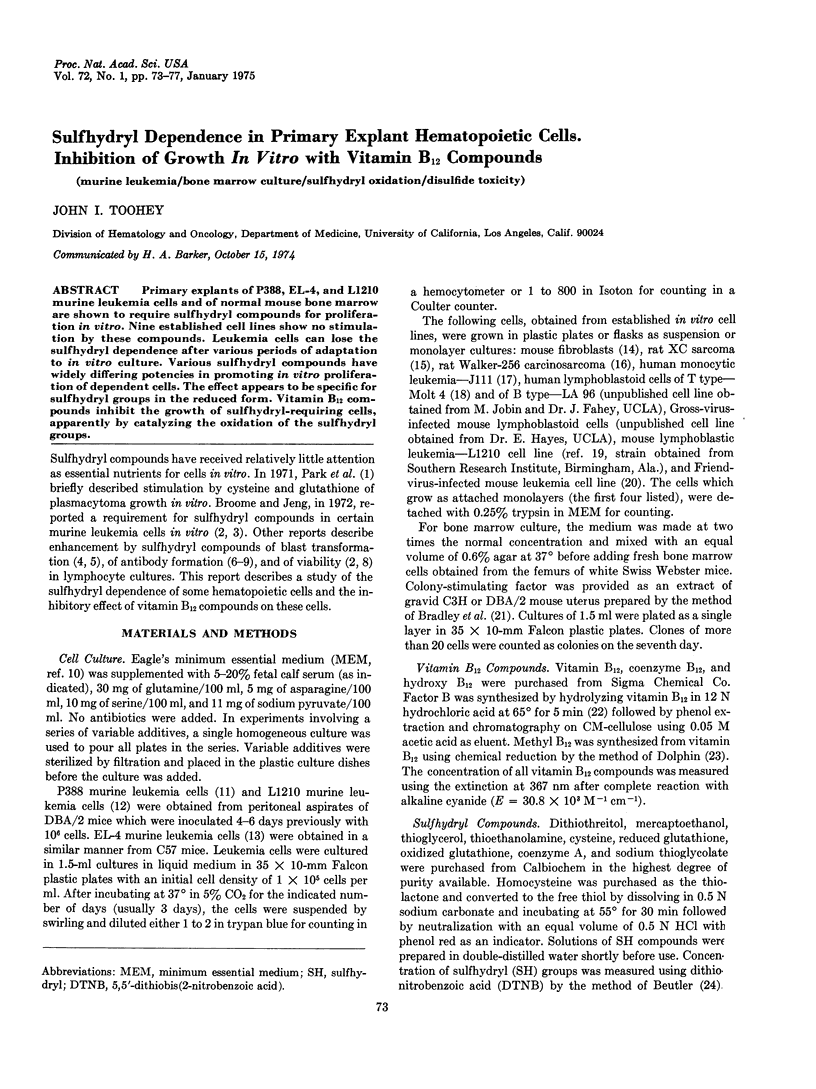
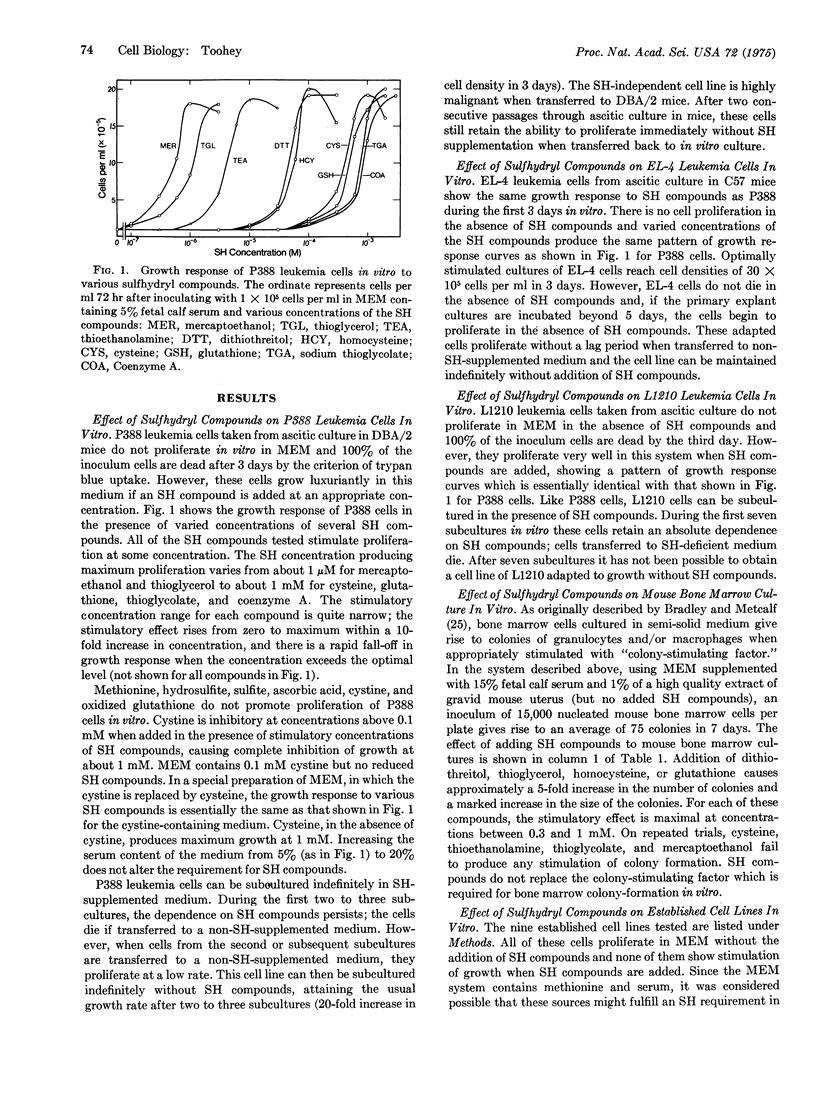
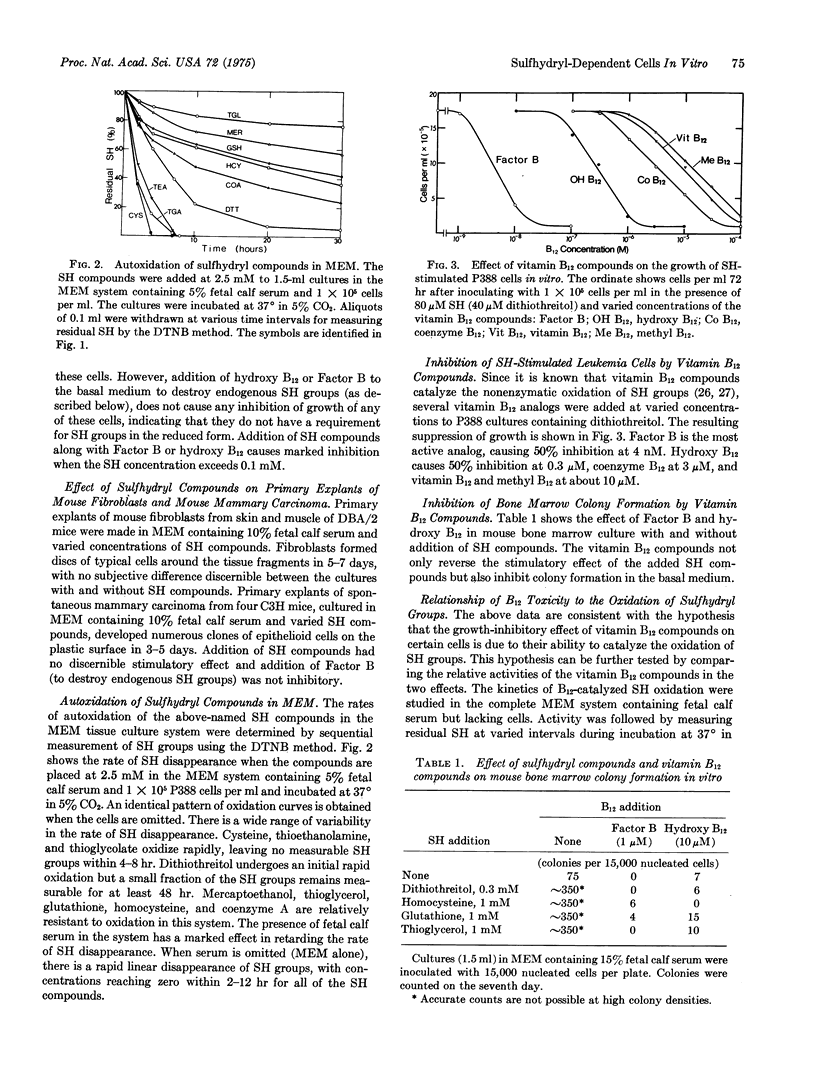
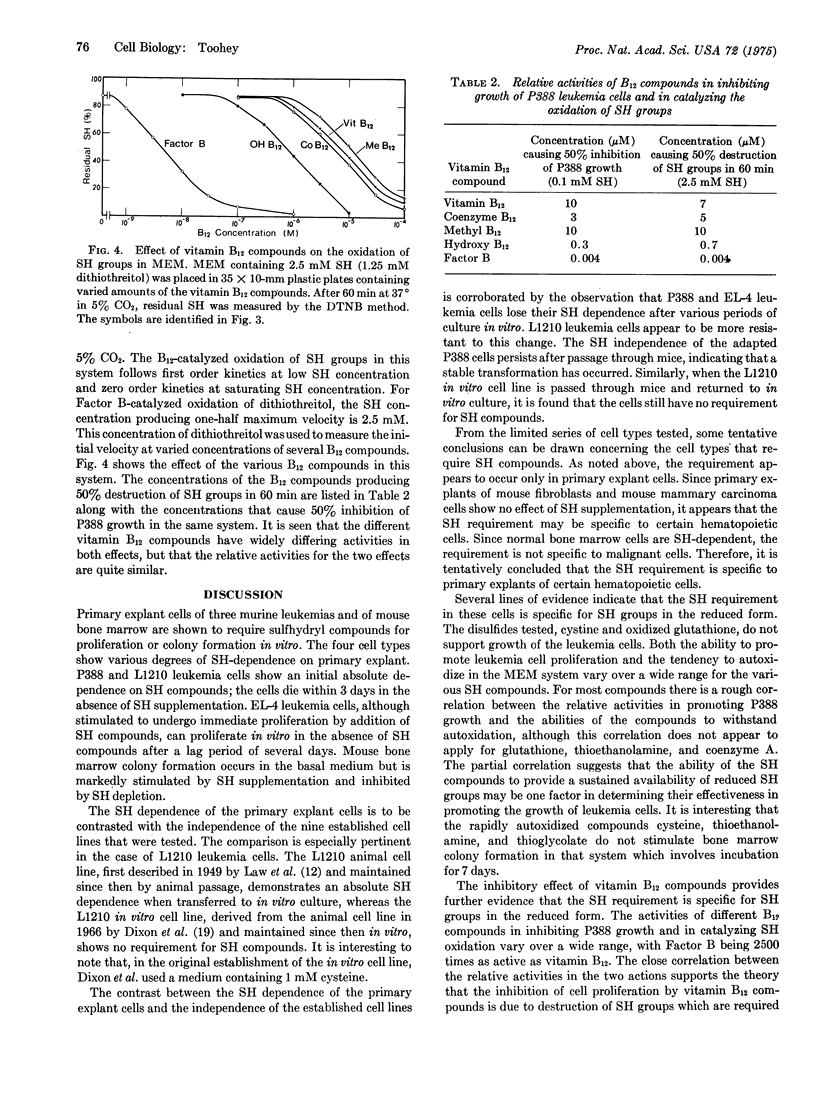
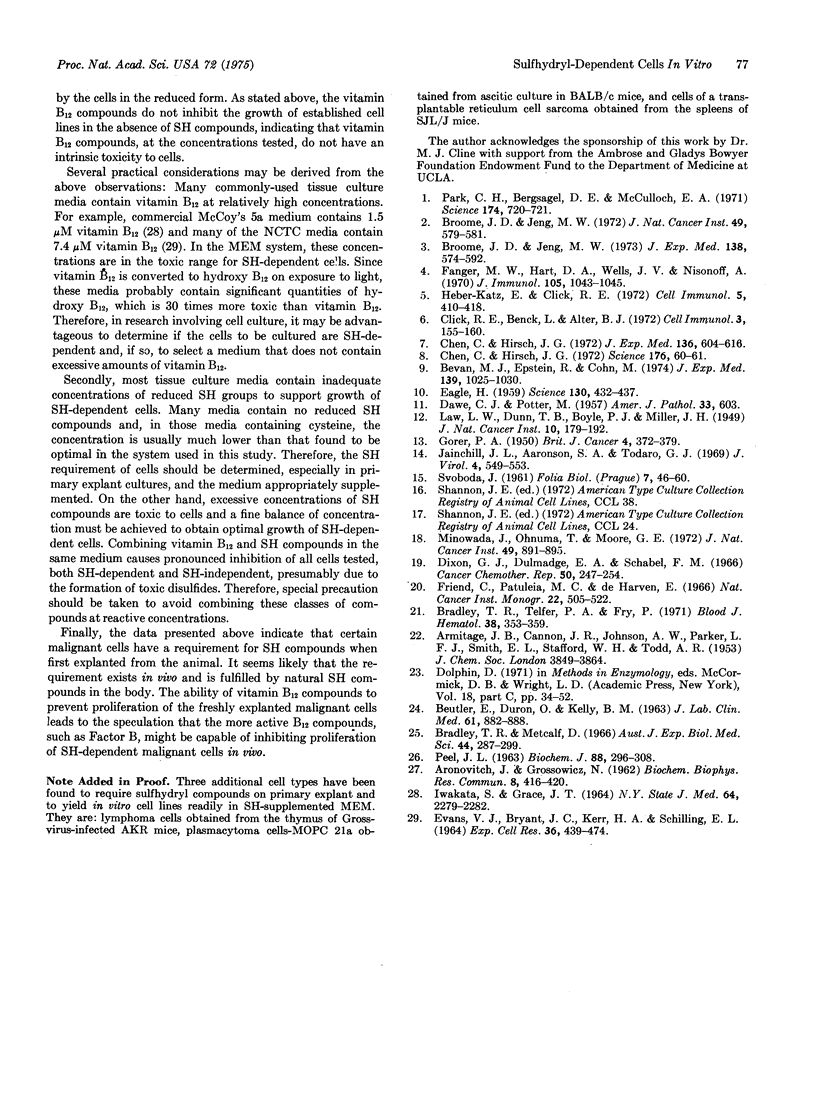
Selected References
These references are in PubMed. This may not be the complete list of references from this article.
- ARONOVITCH J., GROSSOWICZ N. Cobalamin catalyzed oxidation of sulfhydryl groups. Biochem Biophys Res Commun. 1962 Aug 31;8:416–420. doi: 10.1016/0006-291x(62)90288-7. [DOI] [PubMed] [Google Scholar]
- BEUTLER E., DURON O., KELLY B. M. Improved method for the determination of blood glutathione. J Lab Clin Med. 1963 May;61:882–888. [PubMed] [Google Scholar]
- Bevan M. J., Epstein R., Cohn M. The effect of 2-mercaptoethanol on murine mixed lymphocyte cultures. J Exp Med. 1974 Apr 1;139(4):1025–1030. doi: 10.1084/jem.139.4.1025. [DOI] [PMC free article] [PubMed] [Google Scholar]
- Bradley T. R., Metcalf D. The growth of mouse bone marrow cells in vitro. Aust J Exp Biol Med Sci. 1966 Jun;44(3):287–299. doi: 10.1038/icb.1966.28. [DOI] [PubMed] [Google Scholar]
- Bradley T. R., Telfer P. A., Fry P. The effect of erythrocytes on mouse bone marrow colony development in vitro. Blood. 1971 Sep;38(3):353–359. [PubMed] [Google Scholar]
- Broome J. D., Jeng M. W. Growth stimulation of mouse leukemia cells by thiols and disulfides in vitro. J Natl Cancer Inst. 1972 Aug;49(2):579–581. [PubMed] [Google Scholar]
- Broome J. D., Jeng M. W. Promotion of replication in lymphoid cells by specific thiols and disulfides in vitro. Effects on mouse lymphoma cells in comparison with splenic lymphocytes. J Exp Med. 1973 Sep 1;138(3):574–592. doi: 10.1084/jem.138.3.574. [DOI] [PMC free article] [PubMed] [Google Scholar]
- Chen C., Hirsch J. G. Restoration of antibody-forming capacity in cultures of nonadherent spleen cells by mercaptoethanol. Science. 1972 Apr 7;176(4030):60–61. doi: 10.1126/science.176.4030.60. [DOI] [PubMed] [Google Scholar]
- Chen C., Hirsch J. G. The effects of mercaptoethanol and of peritoneal macrophages on the antibody-forming capacity of nonadherent mouse spleen cells in vitro. J Exp Med. 1972 Sep 1;136(3):604–617. doi: 10.1084/jem.136.3.604. [DOI] [PMC free article] [PubMed] [Google Scholar]
- Click R. E., Benck L., Alter B. J. Enhancement of antibody synthesis in vitro by mercaptoethanol. Cell Immunol. 1972 Jan;3(1):156–160. doi: 10.1016/0008-8749(72)90237-7. [DOI] [PubMed] [Google Scholar]
- Dixon G. J., Dulmadge E. A., Schabel F. M., Jr Growth requirements and biologic characteristics of leukemia L1210 cells in culture. Cancer Chemother Rep. 1966 Jul;50(5):247–254. [PubMed] [Google Scholar]
- EAGLE H. Amino acid metabolism in mammalian cell cultures. Science. 1959 Aug 21;130(3373):432–437. doi: 10.1126/science.130.3373.432. [DOI] [PubMed] [Google Scholar]
- EVANS V. J., BRYANT J. C., KERR H. A., SCHILLING E. L. CHEMICALLY DEFINED MEDIA FOR CULTIVATION OF LONG-TERM CELL STRAINS FROM FOUR MAMMALIAN SPECIES. Exp Cell Res. 1964 Dec;36:439–474. doi: 10.1016/0014-4827(64)90302-7. [DOI] [PubMed] [Google Scholar]
- Fanger M. W., Hart D. A., Wells J. V., Nisonoff A. Enhancement by reducing agents of the transformation of human and rabbit peripheral lymphocytes. J Immunol. 1970 Oct;105(4):1043–1045. [PubMed] [Google Scholar]
- Friend C., Patuleia M. C., De Harven E. Erythrocytic maturation in vitro of murine (Friend) virus-induced leukemic cells. Natl Cancer Inst Monogr. 1966 Sep;22:505–522. [PubMed] [Google Scholar]
- GORER P. A. Studies in antibody response of mice to tumour inoculation. Br J Cancer. 1950 Dec;4(4):372–379. doi: 10.1038/bjc.1950.36. [DOI] [PMC free article] [PubMed] [Google Scholar]
- Heber-Katz E., Click R. E. Immune responses in vitro. V. Role of mercaptoethanol in the mixed-leukocyte reaction. Cell Immunol. 1972 Nov;5(3):410–418. doi: 10.1016/0008-8749(72)90067-6. [DOI] [PubMed] [Google Scholar]
- Jainchill J. L., Aaronson S. A., Todaro G. J. Murine sarcoma and leukemia viruses: assay using clonal lines of contact-inhibited mouse cells. J Virol. 1969 Nov;4(5):549–553. doi: 10.1128/jvi.4.5.549-553.1969. [DOI] [PMC free article] [PubMed] [Google Scholar]
- Minowada J., Onuma T., Moore G. E. Rosette-forming human lymphoid cell lines. I. Establishment and evidence for origin of thymus-derived lymphocytes. J Natl Cancer Inst. 1972 Sep;49(3):891–895. [PubMed] [Google Scholar]
- PEEL J. L. THE CATALYSIS OF THE AUTO-OXIDATION OF 2-MERCAPTOETHANOL AND OTHER THIOLS BY VITAMIN B12 DERIVATIVES. POLAROGRAPHIC AND OTHER INVESTIGATIONS. Biochem J. 1963 Aug;88:296–308. doi: 10.1042/bj0880296. [DOI] [PMC free article] [PubMed] [Google Scholar]
- Park C. H., Bergsagel D. E., McCulloch E. A. Ascorbic acid: a culture requirement for colony formation by mouse plasmacytoma cells. Science. 1971 Nov 12;174(4010):720–722. doi: 10.1126/science.174.4010.720. [DOI] [PubMed] [Google Scholar]


